List of cultural monuments on the Frankfurt Südfriedhof
The list of cultural monuments in Frankfurt-Sachsenhausen lists all cultural monuments within the meaning of the Hessian Monument Protection Act in Frankfurt-Sachsenhausen , a district of Frankfurt am Main . For reasons of size, the list is divided into three sub-lists ( list of cultural monuments in Frankfurt-Sachsenhausen (A – K) , list of cultural monuments in Frankfurt-Sachsenhausen (L – Z) and this list of cultural monuments on the Frankfurt Südfriedhof .
Buildings and memorials
| image | designation | location | description | construction time | Data |
|---|---|---|---|---|---|
 more pictures |
Südfriedhof, head building | Darmstädter Landstrasse 229 Location floor: 564, parcel: 153/92 |
The mourning hall in the style of the Florentine baroque was designed by the city inspector Koch at the time and was only built later in 1896. The interior was done by the history painter Leopold Bode . The mourning hall was largely destroyed in World War II and rebuilt in 1950. Portal buildings of the cemetery opened in 1868, built according to plans by J. Lieblein in a style between late classicism and neo-renaissance. Central dome building on a Byzantine floor plan with arcaded connection of the wing structures. | 1896 |
153575 |
 more pictures |
Honor grove and memorial First World War |
location |
The central memorial is made of yellow sandstone. On the mighty pedestal is the larger than life sandstone sculpture of a seated woman with a laurel wreath in her hand, which can be seen as grieving Germania . The memorial is signed Wilh. Müller, arch. inv .; C&C Welb building contractor; Franz Krüger 1883, sculptor. Inscription: “The Warrior Comradeship Frankfurt a. M. her comrade who died there in 1870–1871 ”. | 1883 | |
 more pictures |
Obelisk for the French soldiers who died in 1870/71 |
location |
Obelisk made of polished granite for the French soldiers who died in Frankfurt in the Franco-German War 1870–1871. Inscription: "A la mémoire des Soldats Francais Dècédés à Francfort 1870–1871 - Leurs Compatriotes 1881" | 1881 | |
 more pictures |
Limestone stele First World War |
location |
Limestone stele with helmet sculpture. Inscription: “1914-1918 Our comrades who fell in World War I, the Warrior Comradeship Frankfurt a. M. erected on May 6, 1928 " | 1928 |
Graves
| image | Won | Name (s) | year | Stonemason | description |
|---|---|---|---|---|---|
 |
A 23-25 | Holzammer | 1904 | Jean Schad | Traditional cross stele made of marble . |
| A 53 | Walther | 1890 | Jean Schad | Column stele in neo-renaissance forms made of red sandstone . | |
 |
A 90-91 | Humser | 1880 | Jean Schad | Aedicula in renaissance forms made of yellow sandstone with tables of marble. |
 |
A 92 | Dept | 1878 | Erhard Ackermann | Übergiebelte stele with indicated Eckakroteren of polished red granite , centrally accentuated by a portrait relief of Galvanobronze (Note: At the time of recording the portrait was removed). |
 |
A 93-97 | Gerold | 1872 | Johann Hössbacher | Cross stele (the original marble cross was replaced by a metal cross) on a high, gabled sandstone base. The gable and corner acroters are decorated with palmette reliefs. Extended in 1921/23 with two sandstone pedestals for marble urns . |
 |
A 116 | Schmidt | 1905/1924 | Giulio Cesare Augusto Varnesi | Aedicule-like monument with a double face in classical form made of artificial limestone. A relief-decorated crater is set in the niche in front of the mosaic back wall, with wreath reliefs on the sides. The design is by Carl von Faber (1905), the execution by Varnesi (1924) |
 |
A 117 | Osse-Loder | 1871 | Weitbrecht in Offenbach | Neo-romantic aedicula with a cross made of red sandstone. |
 |
A 118 | Schmidt | 1871 | Weitbrecht in Offenbach | Late classicist stele made of red sandstone with a crowning cross on the roof, which is decorated with corner acrotera and separated from the base by a projecting cornice. |
 |
A 131 | Crabapple Strobel | 1912 | Neoclassical aedicula with wing walls in Egyptian shapes made of bush hammered Odenwald granite. In the niche there is a relief plaque made of galvanized bronze with a name cartouche, framed by renaissance tendrils | |
 |
A 137 | piper | 1922 | Jean Schad | Simplified neoclassical aedicula made of bush-hammered granite with a dominant marble relief of a seated mourner. |
 |
A 169-170 | Simrock-Andreae | 1914 | Jean Schad | Ensemble of simple marble crosses on a sandstone base. |
 |
A 210 | Büdinger | 1913 | EC clapping | Modeled on an aedicule, stele with pedestals arranged on both sides for (no longer existing) bronze plant boxes made of polished dark granite. The view is dominated by a life-size sculpture of a mourning woman made of electroplated bronze (this is not in the picture). |
| A 223-224 | Rumbler-Elsemüller-Gutkaes | 1910 | Nau & Mahr | Neoclassical stele made of polished red Swedish granite, based on the basic shape of an aedicula, as a frame for an urn made of white Italian marble with a crater garland. A portrait relief on the front of the stele, raised palm branches on the back. | |
| A 234 | Rumbler helper | 1914 | Wagner brothers | Aedicula in strict neoclassical forms with an integrated flower bowl made of red Swedish granite. Square reliefs with mourning figures made of galvanized bronze are embedded in the pillars. | |
 |
A 240 | Greitner | 1920 | Design by Hermann Geittner , architect | Three-lane stele made of shell limestone, individually designed by translating traditional forms into Art Nouveau . Reliefs of mourners can be found on both sides above the inscription tablets, which are arranged as in the columbaria. |
| A 242 | Wentzel | 1914 | F. Hofmeister | Three-part neoclassical stele made of dark granite with a serial galvano bronze relief of a mourning angel. | |
 |
A 246-248 | Röhling-Mayer | 1914 | Jean Schad | Monumental neoclassical monument, borrowed from a Doric temple facade, made of shell limestone with axially positioned electroforming of a life-size figure of Christ. Design: Peter Umpfenbach , architect |
 |
A 289 | Gaehl | 1901 | Jean Schad | Traditionally, a base made of polished granite, horizontally divided by cornices, serves as a pedestal for the sculpture of an angel. Engel: Galvanoplastische Kunstanstalt Geislingen |
 |
A 312-313 | Spoonbill | 1896 | M. Loeffler | Stele shaped by sculptural work on all sides in a historical mix of styles made of green sandstone. Design and execution: M. Löffler, construction business |
 |
A 310-311 | Oskar summer | 1894 | Aedicule-like sandstone stele with abundant relief decoration based on the Renaissance model, which also shaped his architectural designs (including the Städel and Börse in Frankfurt am Main); in the center a portrait relief. Design: Friedrich Sander , medallion relief: Louise Schmick . | |
 |
A 331-332 | Dörrstein-Goldschmidt | 1907 | F. Hofmeister | Obelisk-like granite stele, crowned by a fire basin , on the base of an older monument. In the roughly hewn lower plinth, occupied by four urns, there are eight urn niches closed by writing tablets. |
 |
A 323a-325a | Coutou, judge, Petry | 1900 | August Schappel Wwe., Inh. Jean Schappel | Electroplated angel figure with rose on a three-lane base made of polished black Swedish granite with a rock-like base made of Syvenite . |
| A 342 | Dauth | 1913 | Nau & Mahr | Granite aedicules in strict neoclassical forms, reminiscent of Mycenaean buildings. | |
| A 344 | Geyer | 1913 | Nau & Mahr | Neoclassical aedicula made of polished granite, traced back to the basic forms, a palm frond relief made of galvanized bronze above the tablet. | |
 |
A 363 | Geittner | 1902 | Sandstone stele crowned by a cross in Renaissance style. In the tympanum of the round gable there are floral motifs in relief | |
 |
A 346 | Lepple | 1912 | Jean Schad | Neoclassical aedicule, columns and central writing tablet made of polished, base and wing stones made of bush hammered light granite. |
| A 533-534 | Stonemason Johann Schad | 1921 | Jean Schad | Neoclassical arrow pedicels under a monolithic segmented limestone gable with a double inscription niche. | |
 |
A 532 | Seyd | 1905 | F. Hofmeister | White marble stele with a pedestal in front for a serpentine vase . |
 |
A 557 | nail | 1912 | Jean Schad | Neoclassical columned aedicula with triangular pediment made of polished dark syenite. The corner posts of the curved wing walls, which were originally made of bronze, are decorated with an engraved frieze. |
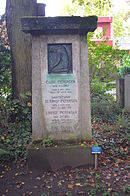 |
A 565 | Pettersen | 1912 | Wagner brothers | Simple stele in the shape of an aedicule made of shell limestone with inlaid serial relief of a mourning angel made of galvanized bronze. |
| A 585 | Gassmann | 1912 | Nau & Mahr | Monument in the form of a pylon made of shell limestone. A relief plate made of galvanized bronze with a girl kneeling in front of an urn is embedded above the writing field. | |
 |
A 612 | Allgeier-Emde | 1906 | F. Hofmeister | Cross stele on a broad, deeply staggered base made of ground and polished dark syenite with a dominant female figure made of galvanized bronze . |
 |
A 634 | Tens | 1907 | F. Hofmeister | Plain writing stele made of white marble with a renaissance tendril frieze under a segmental arch. |
| A 654 | Schaake | 1910 | Wagner brothers | Neoclassical aedicule in polished black Swedish granite. There are bronze planters on the side posts. | |
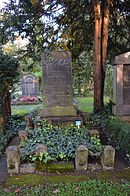 |
A 656 | Bartel | 1911 | Nau & Mahr | Writing stele made of polished greenish granite with renaissance floral ornamental frieze. Base and post of the enclosure made of roughly hewn Odenwald granite. Locking chains between the posts. |
 |
A 667 | Lautenschläger | 1916 | Wagner brothers | Neoclassical aedicula made of shell limestone. A wreath relief in the indicated tympanum. |
| A 719 | Geissler | 1915 | Jean Schad | Typically neoclassical aedicula with lateral, curved retaining walls made of polished dark syenite that end in posts, pillars and flower pedestals made of red granite. | |
 |
A 734 | stone | 1913 | Nau & Mahr | Cross stele on a two-part broad base made of polished Swedish matt green granite. The central sculpture of a woman mourning over an urn and the figure of Christ made of galvanized bronze. |
 |
A 739 | Hartmann | 1916 | Nau & Mahr | Neoclassical pylon-like aedicula made of polished dark granite. A serial relief made of electroplated bronze with the image of a man in ancient clothing mourning over an urn. |
 |
A 743 | Steyer | 1914 | EC clapping | Cross stele between post-bound wing walls made of polished black Swedish granite. The figure of Christ as well as flower boxes and chains of the fence made of bronze. |
 |
A 750 | Fiala | 1916 | F. Hofmeister | Conical written stele with restrained Art Nouveau decoration between curved wing walls made of polished dark-green granite that end in shell-bearing posts. |
 |
A 750 a + b | Löffler-Klein | 1914 | Life-size electroplating of a mourning woman on a three-part base made of polished dark granite. Plastic: Galvanoplastische Kunstanstalt Geislingen, signed: Lovers | |
 |
A 752 | Schlegel-Anhalt | 1916 | F. Hofmeister | Serial writing stele made of polished dark-green granite with floral relief frieze. |
 |
A 771-772 | Arnecke | 1915 | Jean Schad | Stele in provincial forms of the Neo-Renaissance made of red sandstone, inlaid with a tablet made of polished black granite. The area was originally crowned by a granite cross. |
 |
A 1071-1072 | Grosche-Schmidt | 1928 | Relief stele "based on an artistic model" with a female figure wearing a rose between wing walls made of artificial limestone in a monumentality typical of the late 1920s. | |
 |
A 1139 | Becker clover | 1932 | Jean Schad | Aedicula, the gable supported by sturdy double columns, between wing walls made of polished black granite with an axial crucifix relief above the tablet and a sculpture of a mourning woman on the side. |
| A 1148 | Schoder | 1943 | F. Hofmeister | Five-lane bench stele framed by posts made of polished gray-blue Silesian marble. | |
 |
A 1171 | Seyd | 1929 | Paul Anton Seiler , sculptor | Three-lane stele made of cut Grenzheimer Muschelkalk with a central relief depicting the "development of man from birth to death in anticipation of heavenly bliss". |
 |
A 1183 | Marx | 1927 | F. Hofmeister | Urn stele on a rectangular wall stele made of polished dark diabase . |
 |
A adM 11 | Grote | 1878 | Aedicula in neo-renaissance forms made of marble with rich relief decoration in the central field. | |
 |
A adM 23-25 | Cunze | 1907 | Neoclassical pylon-like wall monument made of limestone blocks. The bronze false gate is emphasized by a lion-like door knocker made of the same material. In front of it are two metal flower pots. | |
 |
A adM 57-59 | Johann Gerhard Christian Thomas -Türk | 1838, 1842, 1845, 1848, 1854, 1855 | Ensemble of two cross monuments, stele and wall plate. Relocated in 1898 from the old Sachsenhausen cemetery | |
 
|
A adM 59 | Thierry | 1840, 1867 | Neo-Gothic sandstone stele and female marble sculpture without tomb assignment. Moved from the old Sachsenhausen cemetery in 1898. | |
 |
A adM 66 | Houses | 1932 | Eugen Schreck | Wall stele made of whipped blue bank shell limestone with a relief of a kneeling pilgrim. The tablet was added later. |
 |
B 34-36 | Maull | 1913 | Nau & Mahr | Neoclassical aedicula modeled on Doric temples made of cut granite. |
 |
B 90 | Lenz cod | 1885 | Neo-Renaissance sandstone stele with overemphasized acroteria | |
 |
B 91 | Leux | 1881 | Stela made of white and red sandstone in neo-renaissance forms, crowned by an urn adorned with garlands above a gable-like roof richly decorated with palmette acrotera and volutes | |
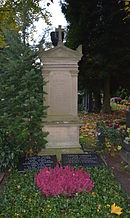 |
B 92 | bird | 1884 | Aedicula in Neo-Renaissance forms made of yellow sandstone, the triangular gable decorated with acroter is crowned with a cross. Drawing signed Krupp | |
| B 92a | Engelhardt-Rudorf | 1934 | Trapezoidal writing stele made of polished black granite, flanked by bank-high wing walls, adorned with a garland made of electroforming | ||
 |
B 93 | Friedrich (Fritz) Wilhelm Reutlinger | 1879 | Obelisk memorial made of red sandstone for the founder of the beer brewery of the same name on the Sachsenhausen mountain. | |
 |
B 96 | Heister | 1893 | Wagner brothers | Baroque decorated marble urn on a polished black granite pedestal. |
 |
B 98 | Holzwarth | 1898 | Wagner brothers | Aedicula in neo-renaissance forms made of polished black granite. In the tympanum of the triangular pediment an angel's head in relief. The posts of the enclosure, connected by metal bars, are also made of granite. |
 |
B 106 | wagner | 1922 | Neoclassical monument in a free interpretation of an aedicule made of shell limestone. In the open, relief frieze, arches emphasized the sculpture of a filled flower bowl. | |
| B 123 | Rumbler | 1886 | Nau & Mahr | Late Classicist aedicula with an elaborately reliefed gable cornice made of sandstone. | |
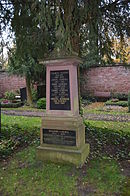 |
B 149 | Schenck | 1888 | Nau & Mahr | Renaissance sandstone stele with urn attachment. |
 |
B 155 | wagner | 1889 | Nau & Mahr | Late Classicist cross-crowned sandstone stele. |
 |
B 169 | Goerich-Kissling | 1945 | Block of inscriptions as a pedestal for the sculpture of a seated mourner between extensive bank-like walls made of artificial limestone | |
 |
B 196 | Harm | 1881 | Neo-Gothic aedicula with a cross made of red sandstone. Drawing signed J. Gebhardt | |
 |
B 205-206 | Büdinger | 1880 | Nau & Mahr | Late classical obelisk stele made of sandstone. |
| B 213 | Hoffmann | 1918 | F. Hofmeister | Writing stele with low wing walls made of polished dark green granite. In the side wings inlaid bronze flower friezes. | |
| B 215 | wagner | 1918 | F. Hofmeister | Identical tomb as B 213 | |
 |
B 220 | Geyer-Dauth | 1890 | Nau & Mahr | Late classicist sandstone stele with polished granite tablets and a cross. |
| B 223 | Bender | 1911 | Nau & Mahr | Neoclassical aedicula reduced to stereometric basic forms with a relief Christ head made of polished dark gray granite. | |
 |
B 226 | Denz-Büdinger | 1889 | Jean Schad | Sandstone aedicula in renaissance forms. |
| B 236 | Nail fisherman | 1886 | Nau & Mahr | Sandstone stele in Neo-Renaissance forms made of sandstone. The writing tablet is made of polished dark granite. | |
 |
B 275 | Nau | 1900 | Nau & Mahr | Neo-Gothic cross stele made of sandstone with tablets made of polished black granite. |
 |
B 308-309 | Euler-Freyeisen | 1894 | Johann Hössbacher | Polished black granite stele as a pedestal for a Renaissance urn. |
| B 225 | brown | 1892 | Nau & Mahr | Serial column monument made of polished black granite. | |
 |
B 227 | Geyer | 1908 | Nau & Mahr | Stele in Neo-Renaissance forms with a flaming basin crowning the volute gable, flanked by vase-bearing pedestals made of polished black Swedish granite and a central portrait relief made of galvanized bronze. |
 |
B 371-372 | Laun-Dielmann | 1898 | Life-size sculpture of a cross-bearing angel on a standardized base made of red sandstone. Drawing signed Adolf Ullrich , sculptor | |
 |
B 453 | Dept | 1929 | Jean Schad | Three-lane stele made of cut Swedish Bluberg granite. A bronze relief with an Orpheus motif over the middle panel protruding like a risalit . |
 |
B 519-520 | warrior | 1901 | Jean Schad | Obelisk stele on a bench-like base made of polished black granite, originally carrying two vases. |
 |
B 521-522 | Burck | 1901 | Jean Schad | Standard obelisk stele made of polished black granite. |
 |
B 600-601 | Matthew | 1906 | Nau & Mahr | Wall plate with an aedicle-like frame in neo-renaissance shapes for a tablet decorated with an angel's head. Material: bush hammered and polished black granite. |
 |
B 678-679 | Kraus | 1903 | Nau & Mahr | Marble urn on a serial base made of polished black granite. |
 |
B 707 | Sorgatz-Modlich | 1962 | Joh. Ferd. Harm | Lettering stele on an square plan made of cut Dalia marble with text in relief as the only design element. |
 |
B 714 | Amm | 1910 | Nau & Mahr | Crucifix made of polished Swedish granite on a three-part base made of pointed Odenwald granite. The dominant sculpture of a woman mourning over an urn as well as the Christ made of electroplated bronze. |
 |
B 724 | Reitz | 1907 | Nau & Mahr | Rock stele with electroplating of a mourner. |
 |
B 746 | Schüssler | 1907 | Jean Schad | Cross memorial over the corner made of polished black granite in a standardized design. |
 |
B 750 | Trauner | 1909 | Nau & Mahr | Neoclassical stele with a cross in relief made of ground and polished Odenwald granite. Enclosure made of Odenwald Felsberg granite with wrought-iron railing in Art Nouveau shapes. |
 |
B 752 | Sussner | 1908 | F. Hofmeister | Neoclassical aedicula with decorative elements of Art Nouveau made of pointed gray granite. The niche-filling tablet is polished and decorated with angel heads. |
 |
B 757 | Assmann | 1911 | Nau & Mahr | Polished syenite obelisk. The side surfaces are filled with floral decor in front of a pointed background. |
 |
B 761 | summer | 1912 | F. Hofmeister | Cross stele on a broad base made of polished black granite, framed by pillars with a bowl attachment. |
 |
B 778 | Dörrstein-Hoffmann | 1908 | F. Hofmeister | Red granite memorial stone with a relief of a grieving angel. |
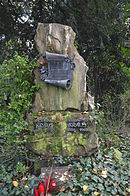 |
B 779 | Kraus | 1908 | Jean Schad | Granite rock stele with an opened scroll made of galvanized bronze. |
 |
B 781 | floor | 1918 | Wagner brothers | Polished granite monument. The central inscription panel flanked by reliefs of grieving angels under a common gable with stylized corner acrotors. |
 |
B 788 | Irmer stork | 1902 | Jean Schad | Galvanoplatic serial angel on a pedestal made of polished black granite. |
 |
B 794 | Bean | 1900 | Jean Schad | Rock memorial made of quartz stone with applied bronze inscriptions. |
 |
B 795 | Hofmann | 1909 | Jean Schad | Rock memorial with an applied scroll made of galvanized bronze. |
 |
B 802 | Weber-Kraus | 1901 | Monumental cross memorial on an octagonal base with inscription mirrors recessed on all sides made of dark granite with different surface treatments. At the base of the cross a sculptural Pietà dominating the monument . | |
| B 803 | Tietz-Wellmann | 1910 | Nau & Mahr | A writing tablet stretched between two obelisk-like pillars with Art Nouveau decoration with a segmental arch made of polished black Swedish granite. | |
 |
B 806 | Sussner | 1909 | Nau & Mahr | Writing stele with a rock-like outline made of polished black Swedish granite, in front of it the sculpture of a grieving girl made of Carrara marble . |
 |
B 807 | Schwab | 1908 | Nau & Mahr | Rock stele made of Taunus rock with an embedded relief plate made of galvanized bronze with the depiction of an angel receiving the child entrusted to him for protection. |
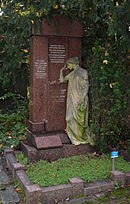 |
B 811 | Bees | 1910 | Nau & Mahr | Neoclassical aedicules made of polished red granite, reduced to their basic shapes, with the sculpture of a mourner made of white marble. |
 |
B 828 | Orth | 1911 | Nau & Mahr | Rock stele made of Taunus rock with inset writing plate. |
 |
B 829 | Huettner | 1912 | Joh. Hösbacher | Taunus rocks with applied plaque in Art Nouveau decor made of galvanized bronze. |
 |
B 830 | shepherd | 1911 | August Bischoff , sculptor | Monument with a edicle-like frame made of red granite for a relief of a cross-bearing mourning female figure made of Savonière limestone. |
 |
B 845 | Spoonbill | 1911 | Jean Schad | Neoclassical aedicula in an upscale standard design made of polished dark syenite, the curved wing walls delimited by a pedestal for planters. |
 |
B 846 | Imfang | 1911 | Jean Schad | Neoclassical aedicula with straight wing walls made of polished dark syenite. |
 |
B 901 | Hieronymi | 1912 | Springer & Schürmann | Neoclassical aedicula made of polished reddish granite with a dominant galvanoplasty of a mourner. |
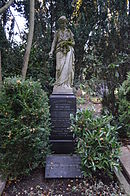 |
B 1022 | fear | 1922 | Nau & Mahr | Polished black granite pedestal for the sculpture of a grieving girl made of marble. Stonemet |
 |
B 1025 | Klingler | 1924 | Nau & Mahr | Small aedicula made of dark Odenwald granite with a central portrait relief made of galvanized bronze. |
 |
B 1148-1149 | lard | 1923 | Nau & Mahr | Small neoclassical aedicula made of dark syenite with a portrait relief made of galvanized bronze. Signed relief: Kraumann |
 |
B 1160b | Rumbler | 1941 | Fritz Best, Kronberg | Relief stele made of polished Grünsfeld shell limestone with the image of a grieving girl, surrounded by numerous symbolic flowers. |
 |
B 1244 | Knodt | 1906 | Nau & Mahr | Three-lane stele made of polished Upper Hessian granite. In the raised central part a round-arched relief of a female figure made of galvanized bronze mourning over an urn. Relief signed AM Wolf |
 |
B 1165 | Schleicher-Schütz-Louven | 1910 | Rupp & Möller, owner Aug. Rupp, Karlsruhe | Monumental inscription plaque stretched between pillars according to traditional templates, wing walls curved into a quarter circle - designed monument of Art Nouveau made of polished dark granite. The pillar capitals replace the heads of girls based on ancient models. |
 |
B 1258 | Oskar Ursinus | 1940 | Carl Stock , sculptor | Storage rectangular stele made of polished yellow Jura. In the recessed central field, an eagle incised. |
 |
B 1265 | Müller | 1928 | Peter Müller jr. | The view shows a three-part stele with an engraved cross in the side writing fields made of sawn blue-gray shell limestone. |
 |
B 1269 | Bonitz | 1928 | Jean Schad | Aedicula-like stele made of polished granite with an embedded relief of a mourning angel made of galvanized bronze. |
 |
B 1274 | Breidenstein | 1953 | F. Hofmeister | Bank-like monument tapering off in quarter circles with an elevated central section additionally emphasized by a cross in relief, in the tradition of the 1940s made of cut travertine . |
 |
B 1279 | Battes | 1931 | Design: Robert Wilms , acd. Sculptor, Koblenz | Standing, cross-shaped monument made of shell limestone with a central relief of a kneeling male figure holding the wheel of time . |
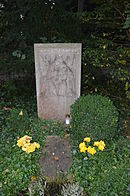 |
B 1292 | Pilgrim Poppe | 1957 | Joh. Ferd. Harm | Standing rectangular stele with a Pietà relief made of limestone. |
 |
C 163 | reed | 1936 | Joh. Hössbacher | Limestone stele in the shape of an offering stick. In the niche a bronze relief of Mary with child. |
| C 243-244 | Matthes | 1921 | Philipp Holzmann AG | Neoclassical portal in a simplified Doric column order with inset tablet made of cut Ettringer tuff stone. In the gable the relief of an owl as an allegory of death. | |
 |
C 297 | Bohnstedt | 1920 | Wagner brothers | Inscribed stele made of artificial stone shell limestone encompassed by snake bodies in an oval. |
| D 49 | from Mylius | 1890 | Nau & Mahr | Neo-Gothic cross stele made of red sandstone. | |
| D 102 | Reidies | 1917 | Nau & Mahr | Serial stele with a marble cross on a sandstone base. | |
| D 106 | Beisinger | 1917 | Nau & Mahr | White marble cross stele. | |
| D 122 | Stöhr | 1918 | Wagner brothers | Stele with an antique finish as the basis for an iron cross . In the base there is a relief with a helmet, sword and olive branch in memory of a fallen warrior. | |
 |
D 129 | Hessler | 1915 | Design: J. Hessler, architect | Stele in the form of an Egyptian pylon with snake reliefs on both sides made of shell limestone. The doorway was closed by a plaque made of polished black marble. |
 |
D 141 | Patronizing | 1918 | F. Hofmeister | Monument with Egyptian colossal polygonal pillars made of polished dark granite. Above the writing surface a bronze relief of a farewell couple based on the representation of the Orpheus myth. |
 |
D 158 | Haun | 1915 | Wagner brothers | Cross stele on a wide base made of polished black Swedish granite. The Christ and the galvanized bronze putti reliefs embedded in the base. |
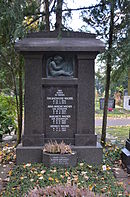 |
D 159 | wagner | 1914 | Nau & Mahr | Aedicular-like stele made of polished dark granite with a relief of an angel playing harp made of galvanized bronze. |
 |
D 181 | Rückmann-Schindler vineyard | 1921 | Three-part stele made of shell limestone with a relief of a grieving putto | |
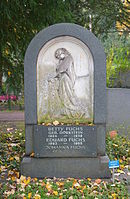 |
D 182 | Dörrstein-Fuchs | 1921 | F. Hofmeister | Round-arched stele made of polished greenish granite. Arch filling a marble relief of a mourner. |
| D 597-598 | Arnold-Wilke | 1907 | Jean Schad | Polished dark granite stele. A bronze relief with the Orphus motif is embedded in it. Relief: C. Cimmi | |
| D 753c | Oswald | 1952 | F. Hofmeister | Asymmetrical stele made of cut Swabian Jura marble with a full-area engraving of the resurrection of Christ. | |
| D 754 | Bischoff | 1940 | F. Hofmeister | Tomb for the woman Maria, who died in 1940, by the sculptor August Bischoff . Geometric stele made of finely bush hammered diabase. Completed at the top with a high relief of a female nude in a sleeping position, including a portrait relief of the artist. Design: August Bischoff. |
The stonemasons
Some stonemason companies are responsible for the execution of many of these cultural monuments. The information in the list relates to the company carrying out the work, not to a specific stonemason.
| company | description |
|---|---|
| F. Hofmeister | The F. Hofmeister company was founded in 1864 by the Frankfurt citizen Ferdinand Hofmeister as a marble workshop. In 1876 the company relocated to its current location, Eckenheimer Landstrasse opposite the main cemetery . In 1898 and 1906, Ferdinand Hofmeister's sons, Rudolf and Willy, became partners. Ferdinand Hofmeister died in 1906, leaving behind a company with 70 employees that sold gravestones across the empire. From 1911 the company operated its own quarry in the Odenwald. Today the company is still in the fifth generation of family ownership. |
| Nau & Mahr | The stonemason company Nau & Mahr was founded in 1876. It is in the 4th generation and is based at Darmstädter Landstrasse 264 opposite the Südfriedhof. |
| Johann Hössbacher | Johann Hössbacher (also Hößbacher) |
| EC clapping | On May 9, 1909, the stonemason company EC Klucken was founded by Engelbert Conrad Klucken. The company remained family-owned until 1974 when Caroline Klucken sold it to Kunigunde Speck. Today the company operates as Steinmetzbetrieb Kreuder & Partner GmbH. |
| Wagner brothers | The gravestone business Gebrüder Wagner was founded by Johann Hermann Wagner (1852-1925). |
literature
- Heinz Schomann, Volker Rödel, Heike Kaiser: Monument topography city of Frankfurt am Main. Revised 2nd edition, limited special edition on the occasion of the 1200th anniversary of the city of Frankfurt am Main. Societäts-Verlag, Frankfurt am Main 1994, ISBN 3-7973-0576-1 ( materials on monument protection in Frankfurt am Main 1).
- Volker Rödel: The Frankfurt district cemeteries. Henrich, Frankfurt am Main 2007, ISBN 978-3-921606-61-2 ( contributions to monument protection in Frankfurt am Main 16), pp. 162-195.
Web links
Commons : Cultural monuments in Frankfurt-Sachsenhausen - Collection of images, videos and audio files
Individual evidence
- ↑ frankfurt.de (PDF)
- ^ Company history F. Hofmeister ( Memento from January 1st, 2015 in the web archive archive.today )
- ↑ Bettina Erche, Dirk Bührmann, Volker Rödel: The Frankfurt main cemetery; Cultural monuments in Hessen, Volume 11 of Articles on Monument Protection in Frankfurt am Main, 1999, ISBN 978-3-921606-35-3 , p. 442
- ↑ List of Frankfurt stonemasons 1945
- ^ History of the Kreuder company